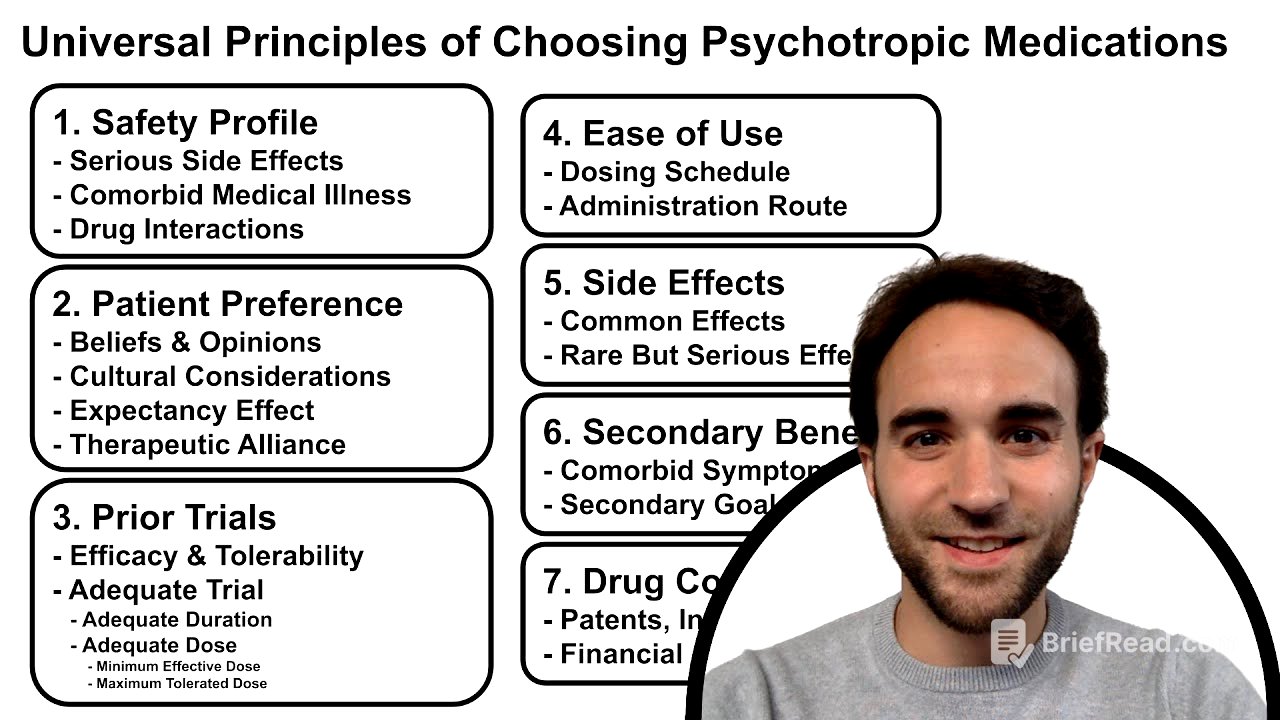TLDR;
This video outlines seven universal principles for choosing psychotropic medications to treat mental illness. The principles, presented in order of importance, include prioritizing medication safety, considering patient preferences, reviewing prior medication trials, assessing ease of use, evaluating side effects, identifying secondary benefits, and considering drug costs. The goal is to provide a framework for making informed decisions about medication treatment while minimizing harm and maximizing patient adherence.
- Prioritize medication safety by avoiding medications where potential harm outweighs benefit.
- Consider patient preferences to improve expectancy effect and therapeutic alliance.
- Review prior medication trials to understand effectiveness, tolerance, dose, and duration.
- Assess ease of use to improve adherence.
- Evaluate side effects to improve adherence.
- Identify secondary benefits by choosing medications that target multiple symptoms.
- Consider drug costs by opting for cheaper generic options when available.
Safety Profile of Medications [0:28]
The primary principle in choosing psychotropic medications is the safety profile. As a doctor, it's crucial to avoid medications where the potential harm outweighs the potential benefit. Factors to consider include the risk of serious or irreversible side effects like organ failure, the presence of comorbid medical illnesses that could increase the risk of serious side effects, and potential drug-drug interactions between the psychotropic medication and other medications the patient is taking.
Patient Preferences [0:57]
The second principle involves considering the patient's preferences, which requires understanding their beliefs and opinions about medication and mental illness, potentially influenced by culture, upbringing, or treatment history. Even if these beliefs seem illogical, it's important to understand and consider them due to the expectancy effect, where a strong belief in a treatment's effectiveness can increase its likelihood of success, and the therapeutic alliance, which impacts treatment adherence. If two medications are similar in safety and effectiveness, choose the one the patient prefers.
Prior Trials of Medications [2:10]
The third principle involves considering the patient's prior trials of medications. It's important to know what medications the patient has previously tried, including how effective it was, how well it was tolerated in terms of side effects, the highest dose that was tried, and the longest duration that was tried. An adequate trial refers to taking a medication consistently as prescribed for an adequate duration and at an adequate dose, specifically the highest dose of the medication that the patient is able to tolerate and is approved by the FDA, also known as the maximum tolerated dose. The minimum effective dose is the lowest dose of medication necessary to achieve the intended therapeutic effect or goal. In general, avoid using higher doses than the minimum effective dose to limit adverse effects.
Ease of Use [3:00]
The fourth principle involves the ease of use, including the dosing schedule (how often the medication needs to be administered in a day) and the administration route (whether it is taken by mouth, injection, a skin patch, or another method). A once-per-day medication is easier to use than a twice-per-day medication, and an oral medication is easier to use than an injection medication.
Side Effects [3:22]
The fifth principle involves considering side effects. A medication with fewer or easier-to-tolerate side effects is going to be easier to adhere to than one with worse side effects. Consider both the common side effects but also the side effects that may occur only rarely but are potentially serious, for example, organ failure, heart arrhythmias, or seizures.
Secondary Benefits [3:42]
The sixth principle involves considering secondary benefits. If possible, choose a medication that targets multiple symptoms or accomplishes multiple goals. For example, if the patient wants to treat both their depression and their chronic pain, consider using an antidepressant that targets both.
Drug Cost [4:00]
The seventh principle involves considering the drug cost. In most cases, newer medications for mental health problems, which are still unpatented and expensive, are no more effective than older medications that were developed many years ago, for which there are cheap generic options available and are more often covered by insurance plans. If you do need to use a more expensive medication, then be aware that there may be Financial assistant programs available for specific medications.
